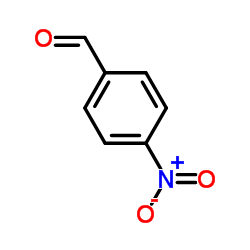4-Nitrobenzaldehyde

4-Nitrobenzaldehyde structure
|
Common Name | 4-Nitrobenzaldehyde | ||
|---|---|---|---|---|
| CAS Number | 555-16-8 | Molecular Weight | 151.120 | |
| Density | 1.3±0.1 g/cm3 | Boiling Point | 299.6±23.0 °C at 760 mmHg | |
| Molecular Formula | C7H5NO3 | Melting Point | 103-106 °C(lit.) | |
| MSDS | Chinese USA | Flash Point | 155.2±15.4 °C | |
| Symbol |

GHS07 |
Signal Word | Warning | |
|
Mechanistic Insight into the Yolk@Shell Transformation of MnO@Silica Nanospheres Incorporating Ni(2+) Ions toward a Colloidal Hollow Nanoreactor.
Small 11(16) , 1930-8, (2015) As an effort to develop a simple and versatile synthetic strategy that contributes to the evolution of hollow nanostructures with increasing complexity and functionality, this research is devoted to study the hollow transformation within a nanosized solid mat... |
|
|
Novel styrylbenzene derivatives for detecting amyloid deposits.
Clin. Chim. Acta 436 , 27-34, (2014) Various styrylbenzene compounds were synthesized and evaluated as mainly Aβ amyloid sensors. These compounds, however, cannot be used for detecting amyloid deposition in peripheral nerves because of the inherent sensitivity of the compounds. These compounds o... |
|
|
Application of 1-(2-pyridylazo)-2-naphthol-modified nanoporous silica as a technique in simultaneous trace monitoring and removal of toxic heavy metals in food and water samples.
Environ. Monit. Assess. 187(1) , 4176, (2015) Solid-phase extraction is one the most useful and efficient techniques for sample preparation, purification, cleanup, preconcentration, and determination of heavy metals at trace levels. In this paper, functionalized MCM-48 nanoporous silica with 1-(2-pyridyl... |
|
|
Fluorescent imino and secondary amino chitosans as potential sensing biomaterials.
Carbohydr. Polym. 123 , 288-96, (2015) A variety of fluorescent imino and secondary amino chitosans were synthesized under very mild conditions by reaction of the biopolymer amino functions with aromatic aldehydes in an acidified methanolic suspension. Simultaneous reactions of several aldehydes w... |
|
|
Helical polymer as mimetic enzyme catalyzing asymmetric aldol reaction.
Macromol. Rapid Commun. 33(8) , 652-7, (2012) This Communication reports optically active helical substituted polyacetylenes which solely catalyzed asymmetric Aldol reaction between cyclohexanone and p-nitrobenzaldehyde; more importantly the helical structures are found to play crucial roles in the asymm... |
|
|
Aldol reactions catalyzed by L-proline functionalized polymeric nanoreactors in water.
Chem. Commun. (Camb.) 48(78) , 9699-701, (2012) The use of functional core-shell micelles as asymmetric catalytic nanoreactors for organic reactions in water is presented. An unprecedented increase in rate of reaction was achieved, which is proposed to be associated with the ability of the nanostructures t... |
|
|
Biochemical properties of human dehydrogenase/reductase (SDR family) member 7.
Chem. Biol. Interact. 207 , 52-7, (2014) Dehydrogenase/reductase (SDR family) member 7 (DHRS7, retSDR4, SDR34C1) is a previously uncharacterized member of the short-chain dehydrogenase/reductase (SDR) superfamily. While human SDR members are known to play an important role in various (patho)biochemi... |
|
|
Determination of trace level genotoxic impurities in small molecule drug substances using conventional headspace gas chromatography with contemporary ionic liquid diluents and electron capture detection.
J. Chromatogr. A. 1361 , 217-28, (2014) Ionic liquids (ILs) were used as a new class of diluents for the analysis of two classes of genotoxic impurities (GTIs), namely, alkyl/aryl halides and nitro-aromatics, in small molecule drug substances by headspace gas chromatography (HS-GC) coupled with ele... |
|
|
Reduction of lipid peroxidation products and advanced glycation end-product precursors by cyanobacterial aldo-keto reductase AKR3G1—a founding member of the AKR3G subfamily.
FASEB J. 29(1) , 263-73, (2015) The purpose of this study was to investigate the origin and function of the aldo-keto reductase (AKR) superfamily as enzymes involved in the detoxification of xenobiotics. We used the cyanobacterium Synechocystis sp. PCC 6803 as a model organism and sequence ... |
|
|
The mimic of type II aldolases chemistry: asymmetric synthesis of beta-hydroxy ketones by direct aldol reaction.
Chem. Biol. Drug Des. 76(2) , 181-6, (2010) An efficient direct aldol reaction has been developed for the synthesis of chiral beta-hydroxy ketone using a combination of C(1)-symmetric chiral prolinamides based on o-phenylenediamine and zinc triflate as catalyst. The reaction was convenient to carry out... |